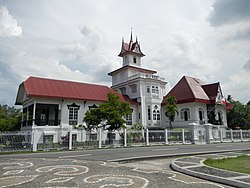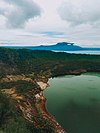| Emilio Aguinaldo Shrine | |
|---|---|
 The façade of the house | |
 | |
| Alternative names | Emilio Aguinaldo House |
| General information | |
| Status | Completed |
| Type | Mansion |
| Architectural style | American Era Filipino Colonial Bahay na Bato |
| Address | Tirona Highway |
| Town or city | Kawit, Cavite |
| Coordinates | 14°26′42″N120°54′25″E / 14.44500°N 120.90694°E |
| Current tenants | National Historical Commission of the Philippines |
| Construction started | 1845 |
| Renovated | 1849 and 1919 |
| Owner | Government of the Philippines |
| Technical details | |
| Floor count | 5 (with a mezzanine level on the second floor) |
| Floor area | 1,324 m2 (14,250 sq ft) [1] |
| Grounds | 4,864 m2 (52,360 sq ft) [1] |
| Design and construction | |
| Architect(s) | Emilio Aguinaldo [2] |
| Designations | National Shrine; June 18, 1964 |
The Emilio Aguinaldo Shrine (or the Cavite El Viejo Shrine) is a national shrine located in Kawit, Cavite in the Philippines, where the Philippine Declaration of Independence from Spain was declared on June 12, 1898, or Independence Day. To commemorate the event, now known as Araw ng Kalayaan or Independence Day , a national holiday, the Philippine flag is raised here by top government officials on June 12 each year. The house is now a museum.



